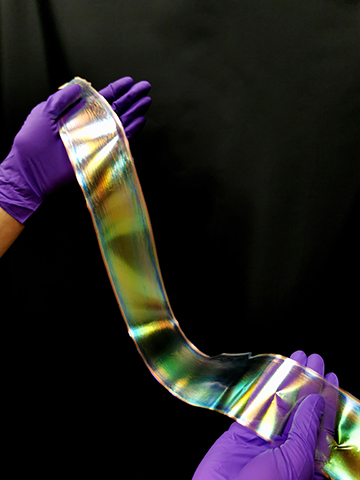![]()
Three vials containing identical photonic cellulose nanocrystals dispersed in three different solvents: water, water:ethanol and ethanol. The color difference between the three vials results from differential swelling of the nanocrystal structure by the different solvents, which leads to a redshift of the particle color depending on the water content. [Image: B. Droguet / University of Cambridge]
Glitter has a reputation for persistence. Whether as leftovers from a school project or as microplastics in waterways, glitter likes to stick around. With a new eco-friendly glitter created by researchers at the University of Cambridge, UK, that’s no longer a bad thing.
Made from plant materials, the new glitter—thanks to adroit use of structural color—is just as sparkly as the plastic-based variety. But now, say the researchers, it is also sustainable, biodegradable, nontoxic and vegan (Nat. Mater., doi: 10.1038/s41563-021-01135-8).
“We managed to fabricate particles with similar color vibrancy to animals and plants that you find in nature, using cellulose extracted from plants,” said Benjamin Droguet, lead author on the new paper and a researcher at Cambridge’s Yusuf Hamied Department of Chemistry. “Moreover, what is exciting is that these particles come in a variety of sizes, from a few millimeters down to a diameter on the order of tens of microns—about the width of a hair—and even the smallest ones we fabricated can have very good color vibrancy.”
From Petri dishes to industrial machines
The new glitter uses the same approach to color—structural color—that’s responsible for iridescent hues in nature, including on butterfly wings and bird feathers. Structural color relies on layers of microscopic surfaces that reflect light and lead to interference, creating vivid colors at different angles.
To create the necessary microscopic structures, the researchers used cellulose nanocrystals, derived from plant material, that self-assemble into a helicoidal, chiral nematic structure upon the evaporation of a solvent. Cellulose nanocrystals had previously attracted interest for creating more sustainable pigments. But finding a way to create films larger than Petri-dish-scale batches remained an obstacle.
Rolling in glitter

A film of the cellulose nanocrystal preparation, peeled from its substrate. The Cambridge research team developed a roll-to-roll processing approach that enables structurally colored films from plant-based materials to be created at meter-scale lengths. The films can subsequently be ground up to provide a plastic-free alternative for use in glitters, cosmetics, pigments and other applications. [Image: B. Droguet / University of Cambridge]
Developing an approach similar to how paper is made from wood pulp, the Cambridge researchers were able to make meter-scale films that could be tuned to a range of colors spanning the rainbow. Called roll-to-roll processing, this technique should, in the team’s view, open industrial applications for the new eco-friendly glitter.
The roll-to-roll approach starts with turning commercially available cellulose into a liquid suspension, which is then deposited, dried, peeled and heat-treated with a commercial machine. The resulting films can then be ground and sorted to create an array of particles sizes for glitter or pigment enhancers.
Lasting color at low energy cost
Since it’s not generally pigment based, structural color doesn’t easily fade. Initial tests of the new glitter have found that it retains its color for more than a year without fading, even in water.
In addition to reducing plastic usage, the method also, the team reports, can reduce energy costs. Common mineral alternatives to plastic, such as mica and titanium dioxide, require baking at high temperatures, which the new process avoids.
Beyond furnishing color for birthday parties and Hallowe’en costumes, the researchers hope that the new glitter can replace plastic-based alternatives in cosmetics. And the cellulose-based films could also, they suggest, be used to make sustainable inks, pigments, beverages, labeling and packaging.
“The method we developed allows us to obtain particles with diameters on the order of tens of microns—much smaller than your usual festive glitter,” Droguet said. “This opens up application in cosmetics, paints, food, packaging, etc., where titania and mica-based pigments are [currently] used to obtain the pearlescent and lustrous effect that customers like.”
